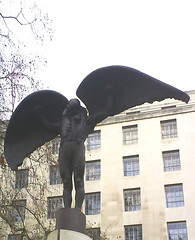According to the Dr's rather fab book on London's various statues,
"The Fleet Air Arm is that part of the Air Force that operates from aircraft carriers. During the Second World War it became the most important and effective part of the Royal Navy. This monument commemorates those who gave their lives in service of the Fleet Air Arm."
Andrew Kershman, London's Monuments, p. 150.
The statue is about halfway between Westminister and Hungerford Bridges, and if the dead man looked up he'd see right in front of him the Royal Air Force Memorial (1923) - the stone column with a sparkly bronze eagle on top of it, which is where the Doctor parked his TARDIS in "Rose".
Probably the Fleet Air Arm's greatest legacy is that they triggered the demise of the battleship - first at Taranato, and then by dooming the Bismarck.
ReplyDeleteIn sadly typical style, the allies learned none of their own lessons, and it was left to the Japanese to finish the job, by sinking pretty much all of our best battleships in just two attacks. They probably did it cheaper, too.
I'm a sucker for anything like this. I might head that way and take a few snaps myself once the weather gets more interesting.
ReplyDeleteJust don't blink.
ReplyDelete